Warships in Evangelion
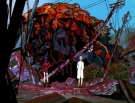
|
"When Aoba called B Wing's construction sloppy he hadn't seen anything like THIS!" |
The Neon Genesis Evangelion franchise is chock-full of warships and references to warships. This page combines the list of World War Two vessels that the characters in the show have been named after with the warships seen on-screen, to give a full list of all the ships that the creators of the franchise have included, one way or the other.
Warship types
The "historical warships" of Evangelion belong to the World War Two era. Some types of ship from that era have gone altogether- for instance, battleships have been mostly relegated to being museum pieces since the 1950s (Except for a few American ships) and the distinction between "heavy" and "light" cruisers is long gone, with nearly all cruiser types being referred to as plain "cruiser". Aircraft carriers are mostly bigger and better (American supercarriers are colossal, but not all carriers are that big), and destroyers have grown to the size of the old light cruisers, with frigates taking the size category of WW2 destroyers.
Aircraft Carrier
An aircraft carrier can be spotted from miles away, literally. A modern Nimitz-class supercarrier is the largest, heaviest warship ever built, more than a thousand feet in length and weighing upwards of 100,000 tons. All aircraft carriers have a flat, wide deck to allow aircraft to take off and land. Modern carriers are found with plenty of aircraft on top and inside, and always accompanied by several escorts. When it comes to the navy, the aircraft carrier is the first and last word in "Peace through Superior Firepower". World War Two carriers were smaller than many of their modern equivalents but carried as many or even more aircraft than modern vessels (the average propeller-driven aircraft was positively dinky compared to a modern jet). Either way, aircraft carriers back during the war performed much the same role as aircraft carriers do today: bring overwhelming power to bear against ships, aircraft and land targets alike.
Battleships
A big-gun battleship is a lot like a samurai sword: magnificent to behold, deadly, powerful and much-feared, but ultimately...pretty useless in modern war. The days of "gunboat diplomacy" ended in World War Two, when Japan and America developed the aircraft carrier to the point that it reigned supreme. A battleship that could sling a shell 45,000 yards was helpless against an aircraft carrier that could bring its planes to bear at a range of 450 miles. Even the most powerful battleships ever built, the Yamato and the Musashi, went down to air attack, and those huge guns turned out to be used far more for shore bombardment than for attacking enemy warships. In the end, battleships landed up supporting landing troops and providing extra anti-aircraft protection to carriers.
Although the word "battleship" is used by some people in place of "warship", it is technically incorrect (and annoying): a battleship is actually a specific type of warship, with huge guns in revolving turrets and plenty of armor to absorb shells from enemy battleships. The term emerged from "Ship of the Line of Battle" which became "Line of Battle Ship" and in the late 19th century, simply "Battleship". At the dawn of the 20th century, any country that owned a battleship belonged to a prestigious, elite group of nations that could throw their weight around (rather like countries owning nuclear weapons today), although they turned out to be vulnerable to mines, submarines and aircraft. There are several preserved battleships in the United States, one of the most famous being the USS Missouri, moored at Pearl Harbor behind the sunken battleship USS Arizona.
Heavy Cruiser and Light Cruiser
Heavy cruisers can be easily confused for battleships, with their big guns and armor plating, but they are always smaller, leaner and far lighter in both armament and armor. These ships started out as "commerce raiders" meant to destroy enemy merchant vessels, as escorts for larger vessels. Many of them were built with powerful engines and a long, narrow hull that gave them the speed to keep pace with fast-moving aircraft carriers, and like battleships, they provided vital fire support to troops on ground.
Light cruisers were less like heavy cruisers, being built with much smaller guns and weaker armor, and were meant mostly to fight smaller surface vessels or lead groups of destroyers into the attack.
Modern cruisers and modern destroyers overlap in their roles, although some Cold War era cruisers are distinguished by being nuclear-powered, which gives them practically unlimited range. The Kirov class missile cruiser is an especially large modern cruiser, and not a new ship type.
Destroyer
Destroyers started out to destroy torpedo-carrying boats that threatened to blow holes in the sides of battleships, hence their name. However, destroyers soon grew in size, speed and destructive power and threatened to blow holes in the sides of battleships themselves. Japanese destroyers from the Second World War were fast, powerful and armed with batteries of torpedoes, which were especially lethal at night, when their wakes wouldn't be seen. Modern destroyers do not use torpedoes in their anti-ship role, instead using them to get rid of submarines.
Modern destroyers use missiles and torpedoes for destroying enemy aircraft, submarines and ships, and in ability and role, largely overlap with modern cruisers. With frigates (the next smaller ship class) catching up in size and firepower, the distinction between "destroyer", "cruiser" and "frigate" among modern vessels is blurred.
Submarine
Submarines, which started out as "submarine boats" or "undersea boats" (The name Unterseeboot in German means exactly that) had been experimented with in several forms during the 19th century but the first truly modern military submarines came into existence at the start of the 20th century, many of them built in Germany. During both World Wars, submarines turned out to be extremely effective at sinking merchant ships - starving Japan of food and essential raw materials in the Second World War and very nearly starving Britain in both wars. Advances in anti-submarine warfare during the Second World War turned the tide against submarines, although modern nuclear submarines are far less vulnerable. Nuclear powered ballistic missile submarines are the most powerful and dangerous naval vessels ever to go to sea.
IJN Akagi(赤城)
(Namesake of Ritsuko and Naoko Akagi)
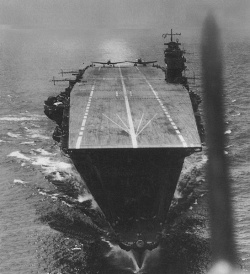
Akagi was one of the most famous of all Japanese warships, and certainly the most famous Japanese aircraft carrier. Akagi was laid down as an Amagi-class battlecruiser in 1920 and converted into an aircraft carrier thanks to the 1922 Washington Naval Treaty, an agreement between America, the United Kingdom, France, Italy and Japan which imposed limitations on warship design and production on all the nations and which proved rather disappointing for Japan, in restricting the total weight of ships that it could build. Akagi's name, which means "Red Castle", comes from a mountain of the same name, Mount Akagi(赤城山,Akagi-san ), in the Gunma Prefecture of Japan (She retained her battlecruiser name, while purpose-built aircraft carriers were named after real or mythical flying creatures). Since Akagi had the hull and engines of the original battlecruiser design (with a hangar and flight deck built on top), it was fast and powerful, one of the best of the early carriers.
Akagi sealed her place in history when she served as the flagship of Vice-Admiral Chuichi Nagumo during the December 7, 1941 attack on Pearl Harbor, launching two waves of aircraft at Oahu. She was constantly active in the following six months, and served on other campaigns in the Pacific, such as supporting the invasion of the port of Rabaul in the Bismarck islands in New Guinea. Her aircraft sunk several ships including the world's first purpose-built aircraft carrier, the British carrier HMS Hermes.
Akagi's final battle was the Battle of Midway, where she would be one of the four Japanese carriers lost, a defeat that would spell the beginning of the end of the Japanese Empire in the Pacific. On June 4, 1942 Akagi was attacked by Flight Lieutenant Richard Best's section of three dive bombers from the aircraft carrier USS Enterprise. Akagi took one hit - from Best himself - on the forward elevator, which started a fire that eventually spread out of all control. A near-miss off Akagi's stern caused shock damage that jammed the rudder. Severely damaged by the fire and exploding ordnance but still floating, she was scuttled the next day by torpedoes from four destroyers. Akagi was the luckiest of the four carriers lost, suffering the fewest deaths among all crew.
As is often the case among warships, Akagi was not the first ship of the Japanese Navy to bear that name. The first Akagi was a Maya-class gunboat of the late nineteenth century. (Rather ironic in Evangelion terms, since Maya Ibuki has an unrequited crush on Ritsuko Akagi) Although she was named after the carrier, Ritsuko's surname is spelt with different characters, as 赤木, which means "Red tree" (the character ki 木 meaning "tree").
IJN Aoba(青葉)
(Namesake of Shigeru Aoba)
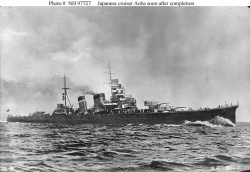
Aoba was the lead vessel in the two-ship Aoba class of heavy cruiser, a little on the older and weaker side when the Second World War broke out, but fairly tough for a ship of its size. It mounted six eight-inch guns in three twin turrets, two facing forwards and one facing the rear of the ship, giving it less firepower than most contemporary cruisers, but compensating in part with its torpedo armament.
As the flagship of Japanese cruiser division six, Aoba was engaged in the invasion of Guam during the time of the attack on Pearl Harbor, being based out of Truk in the Caroline Islands and providing protection for Japanese troops landing on the Solomon Islands.
After seeing off the Battle of Coral Sea, she participated in the Battle of Savo Island in August 1942, where Japanese warships engaged American vessels in a night gun and torpedo battle. The Japanese Navy had invested heavily in torpedoes and night-fighting techniques to counter the significantly larger U.S. Navy, and they put that investment to good effect. Three American warships and one Australian warship were sunk, and three more damaged. The Battle of Savo Island was one of the most humiliating defeats faced by the United States Navy in a straight battle, and the Aoba was a part of it.
At the Battle of Cape Esperance in October of the same year, Aoba was severely damaged by forty 6-inch and 8-inch shells, but eventually returned to Japan for repairs. Serving mostly in escort duties for the rest of the war, she was damaged again and again by aircraft and submarine attacks, and was finally brought to the Japanese port of Kure as a reserve ship after the damage was deemed beyond repair.
Aoba was converted into an anti-aircraft hulk after yet another bombing, and a final bomb raid in July 1945 put this hardy survivor out of action once and for all. Her wreck was scrapped after the end of the war.
IJN Ayanami(綾波)
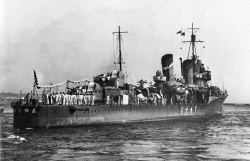
(Namesake of Rei Ayanami)
Ayanami was the first of the Type-II Fubuki class destroyers, an improved version of what was the world's first modern destroyer. Ayanami served as a namesake for her particular model (Although her sister Shikinami was the first to be completed and brought into service, Ayanami had been laid down a full six months earlier).
The old Fubuki-class was bigger, faster and more powerful than any other destroyer type in existence during the 1920s, with fully enclosed bridges and armaments (which protected crews from the elements and provided vastly superior working conditions). The Ayanami subclass was distinguished from the preceding vessels by a gun turret that could elevate to 75 degrees instead of just 40 degrees, making her the first destroyer in the world to have a main gun that could be put to anti-aircraft use (the gun was too slow to aim at aircraft in practice, however). Like other vessels of the Fubuki class, Ayanami was heavily armed, with three triple torpedo tube launchers for the deadly 610mm Type 93 "Long Lance" torpedo, a weapon with a higher speed, longer range and heavier punch than any of its foreign counterparts. Ayanami's torpedoes could blow a gaping hole in any ship at twenty kilometers, while U.S. destroyers would have to close to half the distance to use their own torpedoes.
In December 1941, Ayanami, along with her sister ships Uranami and Yugiri, sank the Dutch submarine O-20 and in March 1942, Ayanami provided close cover for the invasion of the Andaman Islands in the Bay of Bengal. In addition, she served as an escort for Admiral Yamamoto's main body during the Battle of Midway, forming Destroyer Division 19 along with her sister ships Isonami, Shikinami and Uranami.
Ayanami's last action was the Second Battle of Guadalcanal on the night of November 14-15, 1942, along with the Uranami and Nagara, sinking or inflicting severe damage on multiple U.S. destroyers before being spotted and shelled by the battleship USS Washington. Suffering critical damage and with forty of her crew killed, the rest evacuated either to Guadalcanal by boat or to the Uranami. She was scuttled by a single torpedo from the Uranami. Her wreck was discovered at the bottom of Ironbottom Sound by marine archaeologist Robert Ballard(of Titanic and Bismarck fame) in late July 1992.
IJN Fuyutsuki(冬月)
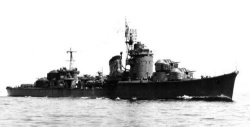
(Namesake of Kozo Fuyutsuki)
Fuyutsuki was an Akizuki-class destroyer of the Japanese Navy, her name literally meaning "Winter Moon." For a fairly advanced and potent vessel, her wartime record is pretty sketchy. Fuyutsuki does have one claim to fame: she rescued survivors from the Yamato after the mighty battleship was sunk by American aircraft. On August 20, 1945, Fuyutsuki was crippled by a mine, and surrendered unrepaired and without armament. Three months later she was struck from the Navy List, serving as a breakwater before being scrapped.
IJN Hyuga(日向)
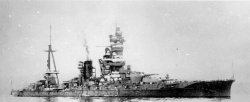
(Namesake of Makoto Hyuga)
Hyuga was built as an Ise-class battleship, a heavily redesigned version of the previous Fuso-class battleship. Both these battleship types were strange-looking ships, with main gun turrets along most of their length. Their armor had to be thinned due to being distributed along such a significant portion of the ship's length, which made them somewhat poorly protected. Completed in 1918, Hyuga was updated extensively between 1926 to 1928 and again between 1934 to 1936.
After the disastrous Battle of Midway where four aircraft carriers were lost, the IJN considered converting all battleships except for the Yamato and Musashi into aircraft carriers, eventually settling on a scheme of converting the oldest and least useful battleships into hybrid battleships/carriers, having the aircraft take off from the battleship-carriers and land on conventional carriers or land bases. In the end, the lack of aircraft and the sheer impracticality of the arrangement made Hyuga and Ise useless in this role. As a consequence, their role in the war was nearly nil, placed in limbo due to being neither full battleships nor proper carriers.
Hyuga was beached in shallow waters during an attack by American aircraft near Kure in July 1945. After the war's end, she was raised and scrapped.
Hyuga was named for the Hyuga province in Kyushu.
IJN Ibuki(伊吹)
(Another namesake of Maya Ibuki)
Ibuki was a ship that was never completed. She was meant to be an improved version of the powerful Mogami-class heavy cruiser, with the weight limitations of the 1922 Washington Naval Treaty removed to make as good a warship design as possible. Her construction was slowed after the Battle of Midway to give way to aircraft carrier production, before she was converted to a full aircraft carrier herself. However, bombing and acute material shortages made construction impossible by March 1945. She was 80 percent complete when she surrendered to occupying forces in September and was scrapped two years later.
IJN Katsuragi(葛城)
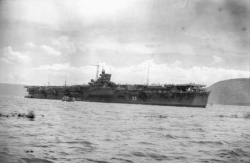
(Namesake of Misato Katsuragi)
Katsuragi was an Unryu-class aircraft carrier of the IJN. The Unryu class took Hiryu's configuration(Hiryu herself being a slightly larger modification of Soryu) and placed the island structure on the starboard/right side of the ship consistently (Akagi and Hiryu had their islands on the port/left). They also replaced the very powerful engines of the Hiryu and Soryu with weaker powerplants borrowed from cruiser or destroyer designs to speed up production and reduce some cost, making them slower. Finished late in the war, Katsuragi did not commit to any serious action, serving mostly as a ferry for "Okha" kamikaze rocket aircraft. Surviving the war, she landed up ferrying returning troops until she was scrapped in 1947.
IJN Kirishima(霧島)
(Non-canonical Mana Kirishima)

Kirishima was a Kongo-class battlecruiser, one of the best warships in the world at the time of her commissioning in 1915, having a superb mix of speed, hitting power and armor protection (Although battlecruisers were poorly armored compared to battleships, the Kongos were well protected for their time). The Kongo class had been designed by Sir George Thurston and Kongo herself had been built by Vickers in Great Britain, with the ships of this class sharing several design features with the British Lion-class battlecruisers. British battlecruisers of the time were built with very limited armor and with a large number of open, non-watertight compartments above the waterline to ease crew movement within the ship, a design detail that would prove fatal.
In 1933-34 she was extensively modernized and converted into a "fast battleship", 4000 tons heavier than before, but retaining many of the original design features. All ships of the class, once modernized, proved to be immensely useful, even if they were the oldest capital ships of the Imperial Japanese Navy. Kirishima served as an escort for the Carrier Striking Force during the attack on Pearl Harbor and beyond, including during their brief rampage in the Indian Ocean and the disastrous Battle of Midway. She participated in the Battle of the Eastern Solomons and the Battle of Santa Cruz. On November 15, 1942 Kirishima engaged American vessels during the Battle of Guadalcanal, inflicting damage on the battleship South Dakota. However, the battleship Washington, only seven kilometers away, had not been spotted, and it shelled Kirishima with radar-directed gunfire from both her main and secondary batteries. Heavily damaged from twenty sixteen-inch shell hits and on fire(no amount of modernization could up-armor her to true battleship standards), Kirishima fled the battle. Damage from the heavy shells caused the upper decks to flood, and the lack of watertightness for the upper decks meant that counterflooding measures to reduce the ship's list only increased the flooding by causing water entering the shell holes to slosh from one side of the ship to the other, eventually causing her to capsize. Her wreck was discovered in 1992 by Robert Ballard (famous for exploring the wrecks of the Titanic and the battleship Bismarck).
IJN Kitakami(北上)

(Namesake of Midori Kitakami) Named after a river, the light cruiser Kitakami was a rather unremarkable vessel of the Kuma-class until it was modified as a "torpedo cruiser" with ten quadruple torpedo tube mounts for a total of 40 (!!!) torpedo tubes. As such, American warships were lucky not to encounter this deadly vessel in a night fight during the early years of the war, when their lack of radar and inferior optics would have made them easy targets for this ship's colossal torpedo firepower. Kitakami never put her torpedo batteries to full use and landed up performing a whole lot of odd jobs during the war, eventually acting as a carrier for the Kaiten kamikaze minisubmarine/manned torpedo. She landed up surviving the war, being scrapped in 1946-47.
IJN Maya(摩耶)

(First namesake of Maya Ibuki)
Maya was one of the four Takao-class heavy cruisers, named after a mountain (摩耶山 Maya-san) near Kobe. This particular class of cruiser was meant to act as a substitute fleet flagship in place of a battleship. As such, Maya and her sisters were distinguished by a huge, battleship-like bridge structure and heavy gun and torpedo armament, and Maya herself would have been a formidable combatant in a fight against American cruisers, had such a battle taken place. She was sunk by submarine attack on October 23, 1944, during the Battle of the Palawan Straits.
The name Maya, like Akagi, was used previously in the Maya class of gunboats, which is ironic given Maya's unrequited crush on Ritsuko Akagi in the series. Further of note is that the mountain is named directly after a person - Maya the Mother of Buddha (摩耶夫人) so it is likely that Maya would share her given name with the ship if both were written in Kanji (as 摩耶).
IJN Musashi(武蔵)
(Non-canonical Musashi Lee Strasberg, Girlfriend of Steel)
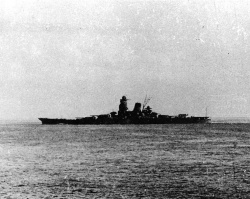
Musashi was the sister ship of the mighty Yamato, one of the two the largest, most heavily armed and armored battleships ever constructed. These monsters had armor two feet thick on their turret fronts, and each of their nine main guns could fire a shell 18 inches in diameter and weighing as much as a family car to a distance of forty kilometers. Unfortunately for the Japanese, their poor choice of engine design had led to these monsters being very fuel-inefficient, and neither of them ventured far.
Serving as Admiral Isoroku Yamamoto's flagship after her commissioning, Musashi was also to return his ashes to Japan (After being killed when the aircraft carrying him was shot down in a special U.S. Army Air Forces operation, a rare 'assassination'). She joined the Yamato for the Battle of Leyte Gulf and on October 24, 1944 she was attacked by American carrier-based aircraft. Struck by 17 bombs and 20 torpedoes (and possibly even more: whatever be the case, this ship took an incredible thrashing), the great battleship keeled over and sank taking over a thousand of her 2399 crew with her, the rest being rescued by the accompanying destroyers. Musashi remained one of the greatest undiscovered shipwrecks of the Second World War and the largest undiscovered shipwreck in history until she was discovered by Paul Allen on March 02, 2015.
IJN Nagara(長良)
(Namesake of Sumire Nagara)
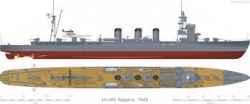
A light cruiser of the early 1920s, named after a river. Rather obsolescent during the outbreak of World War Two, this ship's main claim to fame was being Admiral Nagumo's flagship during the Battle of Midway following Akagi's abandonment. It otherwise served as the lead ship of a destroyer squadron. Torpedoed and sunk by the submarine USS Croaker in 1944.
IJN Soryu(蒼龍 )
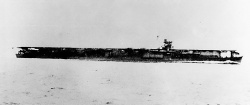
Soryu was the first purpose-built heavy aircraft carrier of the Imperial Japanese Navy, built solely as a carrier and based on the experience learnt with the older carriers Akagi (converted from a half-built battlecruiser) and Kaga (converted from a half-built battleship). At the time of her introduction, she was the fastest carrier in the world, with a speed of 34.5 knots. She was capable of matching the Kaga's maximum speed at only forty percent of her full power, and her twin rudders gave her exceptional maneuverability. Soryu was followed by her modified sister ship Hiryu, which was almost 2000 tons heavier and had a different flight deck and island configuration.
Soryu was one of the six aircraft carriers to take part in the attack on Pearl Harbor, and served in numerous other pacific campaigns in the months to follow. On June 4, 1942, the Soryu was attacked by dive bombers from the USS Yorktown, taking three bomb hits. Two penetrated the upper hangar deck, and the third penetrated down to the lower hangar deck before exploding, breaking water mains, rupturing aviation gas lines, puncturing boiler steam lines and setting off a chain reaction among the armed and fueled planes stored inside the hangar decks. The loss of power led to Soryu being hastily abandoned before being scuttled by destroyer torpedoes later in the night. Soryu's relatively light build caused the ship to suffer exensive structural damage, and the fewer decks posed greater danger to the crews in the engine room and other internal spaces due to the proximity to fires and explosions. She lost 711 of her 1103 crew, the highest fraction of crew among the four carriers lost at Midway, because of the fires being in both her hangar decks.
All purpose-built Japanese carriers were named after mythical or sacred flying creatures. In this case, Soryu literally means green(or blue) dragon. Asuka's surname, although a homophone of the carrier's name, is spelt instead as 惣流, the two Kanji individually meaning "everything/all" and "flow/flux/current/stream".
IJN Sakura and IJN Sumire (suspect)
(May be namesakes of Sakura Suzuhara and Sumire Nagara) IJN Sakura was a Matsu-class destroyer and IJN Sumire was a Matsu Flight-II or Tachibana-class destroyer. This entry has been listed as 'suspect' because both Sakura and Sumire and completely legitimate female names in Japan (Sakura in particular is extremely popular) and the characters may have been named after the same flowers as the warships. This placeholder entry remains pending confirmation that Sakura and Sumire were indeed named after the destroyers in question.
IJN Takao(高雄)
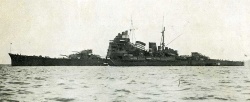
(Namesake of Koji Takao) The heavy cruiser Takao was named after a mountain, in the same vein as Japanese heavy cruisers and battlecruisers. First in its class, it was completed in 1932 and was one of the world's most powerful cruisers at the time, with ten eight-inch guns and sixteen 24-inch torpedo tubes. As such, they were very powerful adversaries for other cruisers, during day or night. The Takao-class were distinguished by their huge bridge structures, which led to them being routinely confused for battleships. Takao was seriously damaged by two torpedoes from USS Darter in 1944. Sent to Singapore, the extent of the repairs made heading for a Japanese yard necessary. With tow impossible at that time in the war, Takao was laid up as a floating AA battery, and was subsequently damaged even further by British midget submarine XE3. It was scrapped after the war.
IJN Tama(多摩)
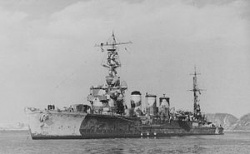
(Namesake of Hideki Tama) Named after a river, the Tama was a Kuma-class light cruiser (the same as the Kitakami). Unlike Kitakami and Oi, it did not undergo "torpedo cruiser" conversion. Tama went about a long number of odd jobs throughout the war before being caught in the Battle of Cape Engano. Torpedoed in a boiler room during a large airstrike, the seriously damanged Tama was sent off towards Okinawa. En route, it was torpedoed and sunk with all hands by the USS Jallao.
Character Namesakes (Japanese Maritime Self-Defense Force vessels)
Due to the changed 'settei' (roughly, 'background') of the main characters in the Rebuild of Evangelion/Evangelion New Movie Edition, Hideaki Anno chose to rename the three female pilots after vessels of the post-war JMSDF rather than of the old Imperial Navy. At present, the three pilots have been confirmed by Anno to have been named for the post-war Ayanami-class destroyer. This information came from a translated interview by Hideaki Anno - previously, Asuka Langley Shikinami and Mari Illustrious Makinami were assumed to have been named after the World War Two era Shikinami and Makinami respectively, and Rei, who retains her original name in full, was assumed to have been named after the same warship as her NGE counterpart.
JMSDF Ayanami (DD-103)
(Namesake of Rei Ayanami in Rebuild) The Rebuild incarnation of Rei Ayanami is named after the first ship of the Ayanami class, which in turn was named after the World War Two destroyer Ayanami (listed above).
JMSDF Shikinami (DD-106)
Placeholder space due to lack of English-language content on the JMSDF Shikinami - the information on her IJN predecessor fills this for now.
IJN Shikinami(敷波)
(Confirmed by Hideaki Anno that Asuka's Rebuild name, Asuka Shikinami Langley, actually comes from the post-war destroyer Shikinami, not from the Imperial Navy vessel. However, it is assumed that the Ayanami-class destroyer has the same Kanji in its name.)
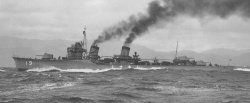
Shikinami was a Type-II Fubuki class destroyer, the same model as the Ayanami. Although she was completed and commissioned before the Ayanami, she was ordered later, and construction on her began a full six months later, which is why her subclass is named "Ayanami" and not "Shikinami". Like all Fubuki-class vessels, she possessed armament and performance well ahead of other destroyers of her time.
Along with Ayanami, Isonami and Uranami, she was assigned to Destroyer Division 19 of the Japanese 2nd Fleet in 1941, and served as an escort in Admiral Yamamoto's main fleet during the Battle of Midway. She survived the Second Battle of Guadalcanal(In which Ayanami and Kirishima were lost) and allied air attacks during the Battle of the Bismarck Sea. She continued serving in escort duties until she was torpedoed and sunk by the submarine USS Growler (SS-215) on 12 September 1944.
Although Asuka's Rebuild incarnation was named after the Shikinami's Ayanami-class namesake, the Kanji used are different. The "Shiki" in Asuka Shikinami stands for "ceremony" rather than for "spreading".
JMSDF Makinami (DD-112)
Last of the Ayanami-class destroyers.
IJN Makinami(巻波)
(Correction - not actually the namesake of Mari Illustrious Makinami, because Mari is named after the post-war Ayanami class destroyer Makinami. Same case as Rei Ayanami and Asuka Shikinami in Rebuild. Confirmed by Anno himself.)
Makinami was a Yugumo-class destroyer, her name meaning "overflowing waves". Makinami escorted the battleships Kongo and Haruna and heavy cruisers Maya and Myoko in the shelling of Henderson Field during the Guadalcanal campaign, running numerous transport runs to the island. She was sunk by torpedoes and gunfire during the battle of Cape St. George on 24-25 November 1943.
USS Langley(CV-1)
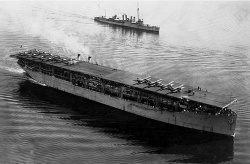
(Namesake of Asuka and her father Langley)
USS Langley was the first aircraft carrier of the United States Navy, being converted from the collier USS Jupiter, the Navy's first ship to have turboelectric propulsion (Steam-powered generators powering electric motors that turn the propellers). Named after aviation pioneer Samuel Pierpont Langley, she was later converted into a seaplane tender. On February 27, 1942, land based Japanese bombers scored five bomb hits on her. Abandoned after fires and flooding, she was scuttled by her escorts. James Lee says "No one actually saw the Langley sink" (perhaps connected with how Asuka's death or turning into LCL is not depicted at all in End of Evangelion). Coincidentally, thanks to the Japanese practice of having a nine-plane unit or chutai, USS Langley faced off the same number of attackers as Asuka did at the end of the series.
DKM Graf Zeppelin

(Namesake of Kyoko Zeppelin Soryu)
Graf Zeppelin was an aircraft carrier of the Deutsche Kriegsmarine (DKM) that was canceled when it was 95 percent complete, resources being diverted to U-Boat construction instead. The incomplete carrier fell into the hands of the Soviet Union. On 16 August 1947, it was sunk in a simulation exercise aimed at sinking a carrier, which was deemed necessary considering a possible future war with the United States. The wreck was discovered close to the Polish port of Łeba in July 2006.
HMS Illustrious
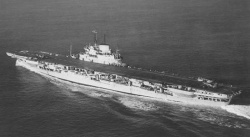
(First namesake of Mari Illustrious Makinami) HMS Illustrious was the fourth ship of her name, an aircraft carrier of the Royal Navy. Nicknamed "Lusty", Illustrious served in the Mediterranean, where she took part in the raid on Taranto, and later suffered extensive damage from aerial attack. After a long period in the Mediterranean and the Indian Ocean, she was shifted to the British Pacific Fleet, covering the landings at Okinawa and taking three strikes from kamikaze aircraft. Seriously damaged in the last strike, she was under repair till the war ended, at which point she was reclassified as a training ship, with her speed restricted to 22 knots by wartime damage. Refitted and modernized in 1948, she served for another six years before being decommissioned and scrapped.
French Battleship Strasbourg
(Possible second namesake of non-canonical Musashi Lee Strasberg - not counting "Lee" as a ship name, which it happens to be.) The French Battleship Strasbourg was the second ship of the Dunkerque class, and built with heavier armor than her sister as a response to the Italian Littorio-class battleships. During the Second World War, Strasbourg escaped serious damage during the British attack on the anchored French fleet at Mers-el-Kebir and headed for Toulon. On 27 November 1942, the Strasbourg was scuttled with the rest of the French fleet at Toulon to prevent its seizure by the Germans. It was refloated by the Italians, seized by the German, sunk again by American air attack, refloated again (and found too badly damaged to be usable), used as a testbed for underwater explosions until condemned and scrapped in 1955.
External Links
http://www.combinedfleet.com/kaigun.htm (This site is superb.)
http://www.hazegray.org/navhist/carriers/ (Links to a number of aircraft carriers)
Warships seen in Episode 08 and Evangelion 3.0
This consists of the real-life vessels that Gainax included in Episode 08 as part of the United Nations Pacific Fleet escorting Eva-02 to Japan. It has been expanded to include the real-life vessels seen in Evangelion 3.0 as AAA Wunder's escort fleet.
USS Harry S. Truman
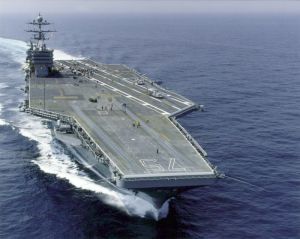
(In Evangelion, it was renamed "Over the Rainbow" and used as Pacific Fleet Flagship. Its reactors provided electrical energy for Eva-02 and the flight deck served as the stage for a short brawl between Eva-02 and Gaghiel in Episode 08.)
USS Harry S. Truman is an American Nimitz-class nuclear powered aircraft carrier, and that makes it one of the most powerful warships afloat, capable of taking ninety to a hundred combat aircraft anywhere in the world. The presence of a Nimitz-class carrier in any part of the world is, in layman's terms, big business. Truman is the eighth carrier, being named after the 33rd President of the United States, Harry S. Truman. Two more Nimitz-class carriers- the USS Ronald Reagan and the USS George H.W. Bush, have been built after the Truman, with additional modifications added along the way.
The Truman was the last carrier built before the year 2000, construction being underway at the time Evangelion aired. When it was officially commissioned (brought into service as a warship) on July 25, 1998, President Bill Clinton was the keynote speaker of the commissioning ceremony. Based in Norfolk, Virginia (As of this writing), her crew has won several awards, and the ship has taken part in numerous exercises and operations. It took part in five weeks of relief efforts in the Gulf Coast following the aftermath of Hurricane Katrina.
http://en.wikipedia.org/wiki/USS_Harry_S_Truman (General information)
http://www.navysite.de/cvn/cvn75.html (Unofficial website)
http://www.truman.navy.mil/ (Official website)
USS Abraham Lincoln
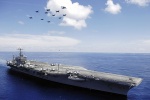
The USS Abraham Lincoln (CVN-72) is a Nimitz-class supercarrier, of the same class as the Harry S. Truman. It is seen in the support fleet for AAA Wunder in Evangelion 3.0. The ship is better known in real life for being the Aircraft Carrier that then-President George W. Bush landed on in the Persian Gulf in 2003 to give his "Mission Accomplished" speech.
USS Independence
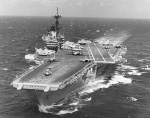
Seen in Evangelion 3.0. The USS Independence (CV-62) was an old Forrestal-class supercarrier of the United States Navy. Built in the 1950s in order to carry the increasingly large jet aircraft that were entering Naval service at the time, the four Forrestal-class supercarriers were the largest in the world at the time of their commissioning, surpassing the Second World War Japanese carrier Shinano in displacement, and greatly exceeding that vessel in both size and aircraft capacity. The nuclear-powered USS Enterprise was a derivative of the Forrestal-class design. The Independence, like all other Forrestal-class carriers, is presently decommissioned.
USS George H.W. Bush
Seen in Evangelion 3.0. The last of the Nimitz-class carriers and a partial transition towards the new Gerald R. Ford class of carriers, USS George H.W. Bush (CVN-77) is one of those rare ships named after a person who had been living at the time of her commissioning - others being the destroyer USS Arleigh Burke and her sister ship, USS Ronald Reagan (CVN-76). It has, among other features, a smaller, repositioned island and a different, modular construction unlike that on older Nimitz-class carriers.
USS Gerald R. Ford

Seen in Evangelion 3.0. The USS Gerald R. Ford (CVN-78) is the first ship of her class of aircraft carrier. Unlike all the other vessels seen in Wunder's support fleet, it was under construction at the time of the show's production and is still not in service. It was christened in November 2013 but still requires additional work before it can be commissioned, and cost cuts mean that it has not been brought into service as of this writing. It incorporates a large number of improvements in design over the Nimitz-class carriers and advanced technology, such as superior electricity generation and aircraft handling, better "future proofing" for later improvements, and electromagnetic rather than steam catapults.
Heavy Missile Cruiser Kirov(Currently Admiral Ushakov)
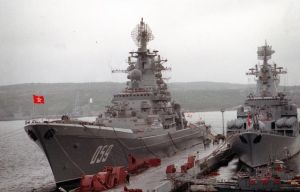
(In-series: Seen only on a display in Episode 08 with the battleships Illinois and Kentucky.)
Kirov was the first ship belonging to Russian Navy Project 1144 Orlan(Sea Eagle, the Russians named big ships after birds), classified by the Russians as a "Heavy Missile Cruiser" and known in the west as the Kirov-class battlecruiser (Note: Russians do not put their ships into "classes" named after the first vessel, as in the west). Kirov and her sister ships Frunze, Kalinin and Yuri Andropov (Renamed Admiral Ushakov, Admiral Lazarev, Admiral Nakhimov and Peter the Great respectively after the fall of the USSR) are the four largest and most powerful missile cruisers ever built, designed to attack American aircraft carriers and their escorts with their huge missiles. Classified as "heavy missile cruisers" in Russia and "Battlecruisers" in the west (Real battlecruisers are long gone, the moniker was adopted due to their size and armament), the appearance of these vessels was a factor in the reintroduction of the World War Two era Iowa class battleships in the 1980s.
Real naval ner...err, fans, please take note of the CBGN designation. NATO designations come direct from the old US Navy designations, and the USN had designated battlecruisers as "CC" (The Lexington class would have been CC-1 to CC-6 had they been completed as such) and used the "CB" designation for the "large cruisers" of the Alaska class. The Kirov CBGN designation would therefore come down to "Large cruiser, guided missile, nuclear", which meshes perfectly with the Russian designation and describes the vessels far more accurately than as "battlecruisers". Why didn't they just call them "large cruisers" or simply "cruisers"? *Shrugs*
Powered by two nuclear reactors with auxiliary steam propulsion (it sounds peculiar, but it actually makes a lot of sense), they carry twenty massive P-700 Granit anti-ship missiles, appropriately called the SS-N-19 "Shipwreck" by NATO. They have a formidable battery of anti-aircraft missiles, and an assortment of anti-submarine and close-in weapons systems, and assorted electronics systems. Weapons and electronics vary from ship to ship, with the last ship, Peter the Great, being the most advanced. At present, the surviving vessels have their condition threatened by poor maintenance and a lack of funding, although the Russian Navy does want to bring them back into their prior operational condition.
http://en.wikipedia.org/wiki/Kirov_class_battlecruiser (General information and links)
http://www.globalsecurity.org/military/world/russia/1144.htm
http://www.fas.org/man/dod-101/sys/ship/row/rus/1144.htm
Iowa class
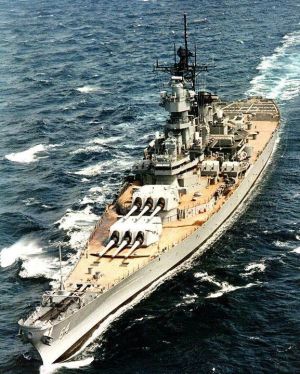
(In-series: Two ships that in real life were canceled while partially complete, Illinois (BB-65) and Kentucky (BB-66), used to destroy Gaghiel in Episode 08. One more Iowa is seen when Eva-02 makes its final landing on the carrier. Five unidentified Iowa-class battleships, all in pre-refit condition, are seen again in Evangelion 3.0 as part of the support fleet for the AAA Wunder.)
The Iowa-class battleships were the last battleships built by the United States Navy, and the most technologically advanced battleships ever made, more powerful than all but the Japanese Yamato class. Originally planned as a class of six battleships, only four were built, with the other two, Illinois and Kentucky, scrapped while still incomplete, in 1945 and 1947 respectively. (Kentucky was to be a missile battleship if completed)[1].
The Iowas served as shore bombardment platforms like most US battleships of the period, and their high speed made them effective anti-aircraft escorts for aircraft carriers, being able to use all their secondary armament to throw up a dense curtain of fire against attacking aircraft as well as act as diversionary targets. The four ships were mothballed after World War II, brought back into action during the Korean War and then mothballed again. In 1968, New Jersey was briefly recommissioned and brought into the Vietnam War. In the 1980s, the class was recommissioned again under Ronald Reagan's 600-ship Navy initiative in the 1980's to fulfill the offshore bombardment role and provide a foil to the Kirov class "battlecruiser" with its very powerful missile armament. Part of the logic in activating them was that battleships had very thick belt armor and would be immune to sea-skimming missiles like the Exocet, which had gained notoriety during the Falklands War. (Whether large supersonic missiles like the Russian P-500 Bazalt or P-700 Granit would fare better is an unanswered question.)
They were heavily modernized and fitted out with electronic warfare systems, Phalanx CIWS, Harpoon anti-ship and Tomahawk cruise missiles. Missouri was used in Operation Desert Storm in 1991, the last wartime use of the Iowa-class. Decommissioned for good in the early 1990s, the last two Iowas were removed from the mothball fleet for good in 2006.
http://en.wikipedia.org/wiki/Iowa_class_battleship
Heavy Aviation Cruiser (Aircraft Carrier) Kuznetsov
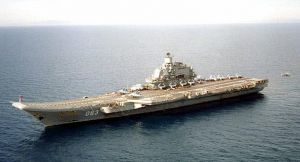
(In series: Kuznetsov seen in a few shots, and appears to have taken damage from Gaghiel. Seen again in Rebuild of Evangelion 3.0 as one of the Aircraft Carriers in Wunder's support fleet.)
Admiral Kuznetsov was built under Russian Navy Project 1143.5, as a larger and far more capable follow-on to the Project 1143, or Kiev-class. Kuznetsov is designated an Aircraft Carrier in the west and a "Heavy Aviation Cruiser" by her builders in order to transition the straits of the Dardanelles. The ship combines an air wing of Su-33 fighters and Ka-27 antisubmarine helicopters with formidable point-defense six-barrel guns and a large missile arsenal, including twelve massive P-700 (SS-N-19) antiship missiles in vertical launchers under the ski-ramp. Western carriers of similar size tend to carry far more aircraft and less guns or missiles, making Kuznetsov's Russian designation at least partially appropriate.
Unlike American carriers that use a steam catapult system to launch aircraft, the Kuznetsov allows aircraft to take off from a ski-ramp on the bow of the ship instead. This reduces the stress on the pilot and aircraft when compared to a catapult launch, but it places a limit on the weight of the aircraft during takeoff. The Su-33 can not take off from the ski-ramp with a full load of fuel and weapons, which restricts its range and forces it to use a light loadout of weapons (mostly air-to-air missiles). Despite these limitations, aircraft on the Kuznetsov can take off and land conventionally, unlike the previous Kiev class carriers which could only carry VTOL(Vertical Takeoff and Landing) aircraft. Furthermore, the Kuznetsov's aircraft are used more as a defensive asset providing air cover for other Russian warships, unlike American aircraft carriers that are used offensively to destroy enemy aircraft, warships and ground forces.
At present, Kuznetsov is only operational carrier of the Russian Navy. In late 2012, Kuznetsov's incomplete sister vessel Varyag was completed by China as the Liaoning, China's first aircraft carrier. Russia has plans to modernize Kuznetsov and equip it with steam catapults like western carriers and replace the old-fashioned steam engines with gas turbines or nuclear reactors.
http://en.wikipedia.org/wiki/Russian_aircraft_carrier_Admiral_Kuznetsov
http://www.globalsecurity.org/military/world/russia/1143_5.htm
http://www.webcom.com/~amraam/rcar.html
Slava Class CGN
Seen in Evangelion 3.0. The "Slava" or Project 1164 Altant is a class of large guided missile cruiser, three of which were built for the Soviet Navy and all of which are in Russian service, albeit with the need for a major overhaul (also, one incomplete hull is still in Ukraine). These powerful vessels carry 16 Bazalt anti-ship missiles and 64 S-300PMU long-range surface to air missiles, in addition to defensive missiles and torpedo armament.
Oliver Hazard Perry class FFG
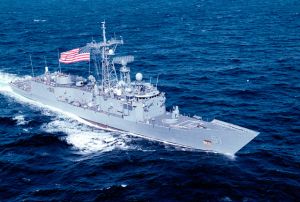
(In-series: Take the brunt of Gaghiel's attack in Episode 08. A number of them are shown burning or exploding.)
The Oliver Hazard Perry class were built in the 1970s and 80s as general-purpose escort vessels to replace a large number of aging World War II era destroyers, and take on a whole number of small roles. Built in two batches (One slightly longer than the other), these vessels are aging and now due for a major refit including a removal of obsolete offensive weaponry.
Nevertheless, the Perry class frigates have proven to be tough vessels for their size. In 1987, the frigate USS Stark was attacked, seemingly by mistake, by Iraqi Exocet anti-ship missiles and sustained severe damage, including the deaths of thirty-seven sailors, but survived. Barely a year later, USS Samuel B. Roberts was damaged by an Iranian mine, and ten severely wounded crewmen had to be taken off the ship.
http://en.wikipedia.org/wiki/Oliver_Hazard_Perry_class_frigate
Kongo-class DDG
(The Japanese Kongo-class DDG is seen in both Rebuild of Evangelion 3.0 and in Episode 08.)
The Japanese Kongo-class DDG is an evolution of the American Arleigh-Burke class design, but with a significantly higher bridge structure to provide improved command facilities, along with construction differences, and different armament and electronics.
Hyuga-Class DDH (helicopter destroyer)
The Hyuga-class helicopter destroyer is actually a small helicopter carrier. Hyuga and her sister ship Ise are named and designated as destroyers so as to avoid violating the pacifistic principles of the Japanese constitution, which prohibits the construction of aircraft carriers, which are considered offensive units. The Hyuga-class and the even larger Izumo-class helicopter destroyers have been subject to significant political controversy due to their potential use as carriers for VTOL aircraft (USMC V-22 Osprey tilt-rotor aircraft have been operated off of these). In addition, the Hyuga and Ise were named after two World War Two battleships that were converted into battleship/carrier hybrids (one of which was the same Hyuga that Makoto Hyuga is named after), furthering the controversy surrounding these ships.
Controversies and politics aside, the Hyuga-class at present is indeed more of a defensive than an offensive unit. It is not configured to carry fixed-wing aircraft of any sort, and the position of the elevators would add further complications to flight deck operations were the operation of fixed-wing aircraft attempted. It is primarily designed for the anti-submarine role, and carries a complement of 11 helicopters in addition to defensive missile armament and Phalanx CIWS. Helicopters are stored below decks in a large internal hangar which is accessible using two elevators, fore and aft.
USS Ramage (Arleigh Burke Class DDG)
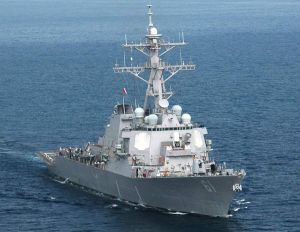
(In-series: Gun turret wrecked by Eva-02 when Asuka went "ship-hopping" in Episode 08.)
The USS Ramage is an Arleigh Burke class Destroyer of the United States Navy, commissioned in 1995. It, along with the other Arleigh Burke class vessels, is one of the largest and most powerful destroyers ever made, built entirely of steel(except for an aluminum mast) to reduce the damage done by antiship missile strikes. Rammage and her sisters have an air-filtration system against nuclear, biological and chemical warfare, the first US ships to use one.
http://en.wikipedia.org/wiki/USS_Ramage_%28DDG-61%29
JMSDF Shirane
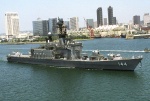
Helicopter-carrying destroyer (DDH), used primarily in the Anti-Submarine role. Seen in Evangelion 3.0 as part of the support fleet for the AAA Wunder.
Sovremenniy Class

A powerful and highly capable class of Russian destroyer, used for Anti-Ship, Anti-Air and Anti-Submarine duties. Seen in Evangelion 3.0 as part of the Wunder's support fleet. These ships were originally supposed to have gas turbine propulsion but centralized restrictions on naval gas turbine propulsion resulted in them being built with somewhat smoky high-pressure steam powerplants - this doesn't seem to have hurt them at all, though.
Udaloy Class
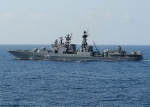
A Russian Anti-Submarine Destroyer. Seen as part of Wunder's support fleet in Evangelion 3.0. Plenty of the Udaloy and the more advanced Udaloy-II destroyers are in service with Russia at present.
Ohio-Class Fleet Ballistic Missile Submarine

Seen in Wunder's support fleet in Evangelion 3.0. American Fleet Ballistic Missile Submarine. Quiet, hard to detect, and able to let loose the apocalypse. Carries 24 Trident ballistic missiles, each with 12 Multiple Independent Reentry Vehicles (MIRVs), for a total of 288(!) nuclear warheads. The first four have been converted to Guided Missile Submarines carrying 168 Tomahawk cruise missiles each, so as to rain conventional munitions instead.
Seawolf-Class Attack Submarine
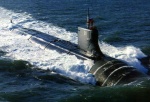
Seen in Wunder's support fleet in Evangelion 3.0. A highly advanced American attack submarine. Very quiet, very large, and equipped with a very expensive and powerful sonar suite. Only three were built due to sheer cost and the collapse of the Soviet Union eliminated the threat of high-speed, deep-diving Russian submarines that the Seawolf was meant to go up against. Followed by the (marginally) cheaper Virginia class attack submarine.
Other Warships in the Show
DDG-099 Farragut
(In-series: Gendo transmits from this vessel, off screen, at the end of Episode 12. Unlike the other warships seen in Neon Genesis Evangelion, it didn't exist at the time the show was made.)
Farragut is an Arleigh Burke-class destroyer of the US Navy, the 49th ship of the Arleigh Burke class. It was laid down on January 9, 2004 and christened on July 23, 2005. http://en.wikipedia.org/wiki/USS_Farragut_%28DDG-99%29
Reference List
